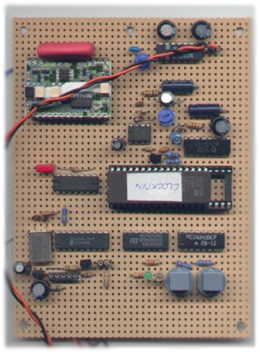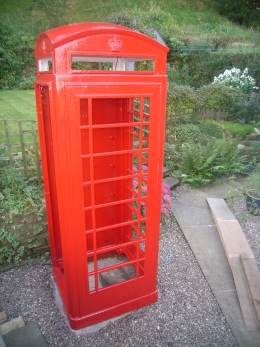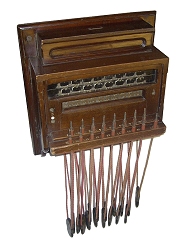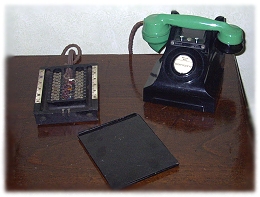|
Projects and News.
|
|
|
I've got a few projects lined up and I will put the details here when I get around to it.
|
|  TIM 2000
TIM 2000
The TIM 2000 speaking clock is still working beautifully. The project
was conceived by Andrew Emmerson as a solid state speaking clock.
Andrew digitised the voice of Pat Simmonds from one of the original
speaking clocks and the data was squeezed into an EPROM. A PIC chip
synchronises the speech. The unit can be connected to a PAX or PABX
and will answer the call, speak the time for just over a minute
and then clear down.
Some initial glitches have now been ironed out and with V3.2 of
the software the unit now synchronises with the MSF (atomic clock)
transmitter at Rugby and is accurate to < 1 second.
The picture shows the prototype. The production version is built
on a very professional PCB.
The unit is connected to extension 36 of the Inspiration. I wanted
to be able to dial TIM and I've got close - I actually have to dial
9 followed by TIM. To do this I looped extension 36 of the Inspiration
to Exchange line 4, and invoked the Least Cost Routing (LCR) option
of the Inspiration. The LCR software watches for 846 (TIM) to be
dialled after a 9. It then exclusively selects line 4 and replaces
the dialled digits with 37. Thus the call is routed to extension
37. I also use LCR to re-direct calls to 123 to TIM 2000! I can
also dial 9, 8081 or 9, 952 which were the other numbers used for
TIM depending on your location and exchange type.
I have just had the PIC re-programmed
to V4.1 of the TIM 2000 software. This version provides a half second
pulse output every 30 seconds to drive mechanical slave clocks such
as those used in exchange rooms and Post Offices. Slave (or impulse)
clocks would normally be driven by a master clock. More information
on slave and master clocks can be found here.
Further information on TIM 2000 can be found here.
|
|
|
Other Projects:
|
|
|
K6 Kiosk
 MY K6C (Mk. 2) kiosk
was made by the Lion Foundry in Kirkintilloch. There are four variants of the K6; A,B,C and D, depending on the position of the door in relation to the backboard. The Mk. 1 K6 was replaced by the Mk. 2 in 1939 and included minor improvements to the casting of the back panel to improve security and to the way the glazing bead frames were held in place. MY K6C (Mk. 2) kiosk
was made by the Lion Foundry in Kirkintilloch. There are four variants of the K6; A,B,C and D, depending on the position of the door in relation to the backboard. The Mk. 1 K6 was replaced by the Mk. 2 in 1939 and included minor improvements to the casting of the back panel to improve security and to the way the glazing bead frames were held in place.
This particular kiosk can be dated to between 1953 and 1955 - it has the later St. Edward style crown as adopted by Queen Elizabeth the second in 1953. However, after complaints from Scotland that Queen Elizabeth was not, in fact, the
second Queen Elizabeth of Scotland, the top casting was modified in 1955 to allow different crowns to be slotted in for different regions. Mine does not have the slots, hence; 1953-1955
The K6 is known as the "Jubilee Kiosk", as it was designed in 1935 by Sir Giles Gilbert Scott at the time of the Silver Jubilee of King George V. I will be fitting it out with the "Jubilee
interior" i.e. A+B coin box, pyramid bakelite telephone and copies of mid / late fifties signage. Click here for a blog of how things are shaping up.
|
|
|
 Magneto Switchboard Magneto Switchboard
This recent acquisition is a 1925 Magneto Switchboard. Its official designation is Switchboard W.P.S.C. NT 5 (i.e. Switchboard Wall Pattern, Single Cord, National Telephone Type 5). So it looks like I'm now set for
a divergence into earlier magneto phones!
The photo shows it as received, but after cleaning. The varnish needs touching up in places, but other than that it looks fine.
|
|
|
 WW II Secraphone WW II Secraphone
I have recently acquired a "Secraphone" or scrambler phone. This is a black 300 type phone with a green handset. It is fitted with two keys; Secret and Engage for Secret. It dates from 1945 and was
manufactured in the Post Office Factory (Holloway). To provide a secret speech path there must be one of these units (and the associated electronics) at each end of the line. The principle of operation is as follows:
(1) The call is initiated in the normal way (i.e. no buttons pressed)
(2) Once the call is set up both parties press their Secret button. Anyone listening in on the line will now hear unintelligable noise.
(3) If the operator tries to attract the attention of the Secraphone users they will hear her as unintelligable and must press their Engage For Secret button to hear her, while holding the secret call.
The Secraphone was originally connected to a Frequency Changer No. 6. This was a box of valve electronics based on the ballanced ring modulator principle. This is a fairly simple technique which uses a reference
frequency (2500Hz) to invert the incoming speech. Say the speech is 100Hz, then the output will be 2500 - 100=2400Hz. If the speech frequency is 200Hz then the output will be 2500 - 200=2300Hz. So the higher the input frequency, the lower the output
frequency. A similar circuit at the remote station reverses the process.
I have a 1970s transistor based circuit for a device to perform the same job, so I hope to get the thing working again in the future.
|
|
|
Plan 7 System
I've finally got the Plan 7 (Internal Scheme) system working. This system was used for manager / secretary working. It uses a Tele 248, Bellset 44 and Bellset 64 as the main telephone and a Tele 328 with Bell 56 as
the extension telephone. One thing I discovered was that you can't use electronic transmitters as the 4.5V speech voltage will not power them.
|
|
|
Home Control
I'm experimenting with home control at the moment. I've got a module which answers a phone call and then allows the caller to switch on / off six relay outputs using DTMF signals. I have fitted a pulse-to-tone
converter between the Inspiration and this unit so I can control the outputs using a dial phone. This is still experimental at the moment. I'll post more later.
|
|
|
Dial a Bedtime Story!
Extensions 34 and 35 of the Inspiration are connected to a tape
announcer onto which I can record a couple of bedtime stories -
fun for the kids. I'm planning on replacing this with a PC-based
auto-attendant. This will allow the caller to choose various recorded
announcements or to be diverted to the Speaking Clock (TIM 2000)
and hopefully listen to various telephone-related recordings. It
will also be controllable from either DTMF or LD telephones! I hope
to have this up and running by September and will post a public
access number here when I go live. The number will be (initially)
an O2 mobile number which is terminated on a Nokia 22 terminal.
|
|

 TIM 2000
TIM 2000
 Magneto Switchboard
Magneto Switchboard WW II Secraphone
WW II Secraphone